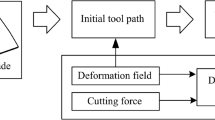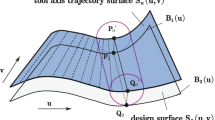Abstract
During milling of free-form surfaces, cutting force varies due to the variation of workpiece surface curvature, which can seriously affect machining quality. In this study, a layered strategy was proposed for flexible machining of complex parts with variable curvatures. By taking a blade as the research object, we first considered a constant cutting force as the starting point. The relationship between the machining allowance and the radius of curvature of the workpiece under a certain cutting force was established. By analyzing the curvature of each position of the blade, a reasonable cutting allowance was set for each layer and the machining process was carried out layer by layer, such that a stable cutting force was maintained on the workpiece surface during machining of each layer. Second, the blade surface deformation law was determined by using the T-spline surface characteristics and an improved offset algorithm, and a series of deformation surfaces was obtained. Finally, the feasibility of the proposed method was verified by using finite element simulations and validated by experiment, and the advantages of the proposed method were verified by comparison with the existing main blade processing methods.



















Similar content being viewed by others
References
Loney GC, Ozsoy TM (1987) NC Machining of free form surfaces. Comput Aided Des 19 (2):85–90
Ren BY, Tang YY (2000) Geometric modeling theory and its application in numerical control machining. Harbin Institute of Technology Press, Harbin
Chen YH, Hu YN (1999) Implementation of a robot system for sculptured surface cutting. Part 1. Rough machining. Int J Adv Manuf Technol 15(9):624–629
Chuang SHF, Wang IZ (2000) Multipatched B-spline surfaces and automatic rough cut path generation. Int J Adv Manuf Technol 16(2):100–106
Sung GL, Hyun CK, Min YY (2007) Mesh-based tool path generation for constant scallop-height machining. Int J Adv Manuf Technol 37(1):15–22
Park JW, Cho HU, Chung CW, Lee YS, Jeon DJ (2012) Modeling and grinding large sculptured surface by robotic digitization. J Mech Sci Technol 26(7):2087–2091
Can A, Unuvar A (2010) A novel iso-scallop tool-path generation for efficient five-axis machining of free-form surfaces. Int J Adv Manuf Technol 51(9):1083–1098
Giri V, Bezbaruah D, Bubna P, Choudhury AR (2005) Selection of master cutter paths in sculptured surface machining by employing curvature principle. Int J Mach Tools Manuf 45(10):1202–9
Sun DZ, Kang XC, Li YR (2011) Efficient algorithm for finishing NC tool path generation based on triangular bézier surface. Chin J Mech Eng-En 15:188–192
Cao LX, Xue YF (2013) Tool-path planning for 5-axis NC rough machining of closed impeller channel. J Dalian Univ Technol 04:514–520
Lauwers B, Lefebvre PP (2006) Five-axis rough milling strategies for complex shaped cavities based on morphing technology. Cirp Ann-Manuf Techn 55(1):59–62
Luo YN, He K, Du RX (2010) A new sheet metal forming system based on the incremental punching, part 1:modeling and simulation. Int J Adv Manuf Technol 51(5-8):481–491
Sederberg TW, Parry SR (1986) Free-form fundamentals of solid geometry. Comput Graph 20(4):151–160
Hu SM, Li YF, Ju T, Zhu S (2001) Modifying the shape of NURBS surfaces with geometric constraints. Comput Aided Des 33:903–912
Sarraga RF (2004) Modifying CAD/CAM surfaces according to displace-ments prescribed at a finite set of points. Comput Aided Des 36:343–349
Biermann D, Sacharow A, Surmann T (2010) Direct free-form deformation of NC programs for surface reconstruction and form-error compensation. Prod Eng 4(5):501–507
Tam HY, Law HW, Xu HY (2004) A geometric approach to the offsetting of profiles on three-dimensional surfaces. Comput Aided Des 36(10):887–902
Qu X, Stucker B (2003) A 3D surface offset method for STL-format models. Rapid Prototyping J 9(3):133–141
Pavic D, Kobbelt L (2008) High-resolution volumetric computation of offset surfaces with feature preservation. In: Proceedings of the computer graphics forum, F, p 2008
Chen Y, Wang CCL (2011) Uniform offsetting of polygonal model based on layered depth-normal images. Comput Aided Des 43(1):31–46
Liu S, Wang CCL (2011) Fast intersection-free offset surface generation from freeform models with triangular meshes. IEEE T Robotic Autom 8(2):347–360
Klass R (1983) An offset spline approximation for plane cubic splines. Comput Aided Des 15 (4):297–299
Hoschek J, Wissel N (1988) Optimal approximate conversion of spline curves and spline approximation of offset curves. Comput Aided Des 20(8):475–483
Jiang DW, Li AP (1995) NURBS Form of spatial isometric lines. Aeronaut Comput Technique 25(2):33–38
Piegl LA, Tiller W (1999) Computing offsets of NURBS curves and surfaces. Comput Aided Des 31(2):147–156
Wang XC, Hu YN, Su JQ (2008) Study on relationship between tool path of curvature and milling force with micro-end mill. Machin Design Manufact 10:205–207
Funding
This work was supported by the National Science and Technology Major Project on CNC Machine tool, China (Grant No. 2019ZX04001001) and National Natural Science Foundation of China (Grant 51975019).
Author information
Authors and Affiliations
Corresponding author
Ethics declarations
Conflict of interest
The authors declare that they have no competing interests.
Additional information
Author contributions
Liu and Zhao conceived and designed the study. Li, Cao and Su performed the experiments. Zhao conducted a data analysis. Liu and Zhao wrote the paper. Liu, Zhao, Li, Cao, and Su reviewed and edited the manuscript. All authors read and approved the manuscript.
Data availability
The datasets used or analyzed during the current study are available from the corresponding author on reasonable request.
Publisher’s note
Springer Nature remains neutral with regard to jurisdictional claims in published maps and institutional affiliations.
Rights and permissions
About this article
Cite this article
feng, L.Z., rui, Z.P., xiong, L.Z. et al. Flexible stratification method based on constant cutting force for machining blade surfaces. Int J Adv Manuf Technol 120, 159–172 (2022). https://doi.org/10.1007/s00170-020-06551-9
Received:
Accepted:
Published:
Issue Date:
DOI: https://doi.org/10.1007/s00170-020-06551-9




